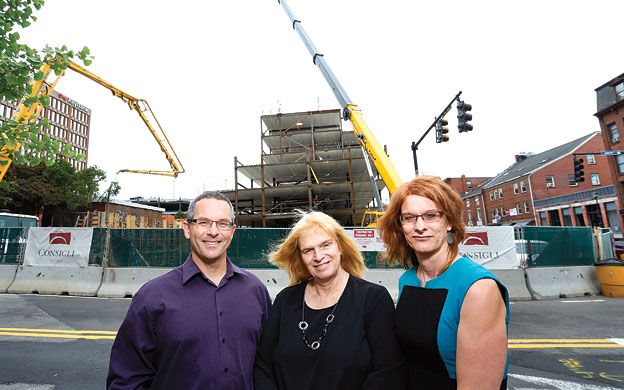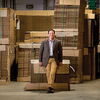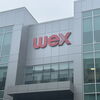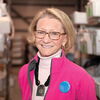Peaks Island entrepreneurs launch sustainable design tool
 PHOTo / Tim greenway
Patrick Costin of Canal 5 Studio in Portland is testing sustainability software created by Introspective Systems co-founders Caryl Johnson, middle, and Kay Aikin. They are standing in front of the Hyatt Place Portland where sustainable building design guides construction.
PHOTo / Tim greenway
Patrick Costin of Canal 5 Studio in Portland is testing sustainability software created by Introspective Systems co-founders Caryl Johnson, middle, and Kay Aikin. They are standing in front of the Hyatt Place Portland where sustainable building design guides construction.
Every new startup is a variation on the theme of wanting to build a better mousetrap.
In the case of the Peaks Island-based Introspective Systems LLC, co-founder Kay Aikin says the company's SIMplexity suite of software tools now under development is designed to help architects and designers create sustainable buildings that deliver the energy and environmental benefits envisioned during the pre-construction concept and design phases.
With Leadership in Energy and Environmental Design (LEED) certification fast becoming the norm for the construction industry, Aikin says Introspective Systems is tackling a significant problem in the architectural workflow — the difficulty of identifying critical decisions early in the planning stages of a sustainable building that, if missed, can drive up costs and limit the building's optimum performance.
A 2008 national study conducted by the New Buildings Institute for the U.S. Green Building Council underscores both the extent of that problem and the business opportunity it presents for Introspective Systems. The study found energy use in more than half of LEED-certified buildings deviated from design projections; while 30% in that group were found to be doing better, 25% were “significantly worse.”
Aikin says the reasons behind that performance shortfall need to be better understood and corrected so that energy-efficiency goals “as designed” become aligned with efficiency “as measured.”
“The sustainable construction design market is growing at a rate of 23% per year,” she says. “We're counting on that growth to drive this business. The driver isn't necessarily LEED certification. It's that clients are skeptical and they're telling architects, 'Show me the money I'll be saving' [with a 'green' or 'LEED' design]. That's the problem we're addressing.”
Early testing
Patrick Costin is no stranger to the challenges facing a startup, having formed the five-member Canal 5 Studio in Portland just two years ago after leaving a prestigious position and 16-year career with Harriman Architects & Engineers. He is among the early testers of Introspective Systems' software.
“Quantifying the data is fairly straightforward,” he says of contemporary approaches to architecture and design. “Quantifying the goals and aspirations of an organization, and how those translate into the built environment, is significantly more challenging. It's an art as much as it's a science.”
Costin says the SIMplexity suite of software tools strikes him as an effective blend of art and science that can help both the architect and client drill down into the business's organizational culture as much as the metrics of sustainability and energy usage. By analyzing and mapping the sometimes conflicting aspirational goals of the client, particular requirements of LEED certification as well as cost and site constraints, the tools are designed to synthesize that information into what Aikin describes as a “programming document that guides but does not limit the actual design process.”
“The designer hasn't drawn anything yet,” she says, explaining that at this stage the process is still at the level of “What exactly are we building … and why?”
Costin says the earlier in the design and pre-construction process those questions can be answered, the better. “The tool they are working on allows for a better understanding of what all the collected data means. It's not just a design brief. It helps me and our clients as well to see if we are truly moving the design toward the goal … so you can stay on track. It makes it less likely over the course of the development of a project that you will wander off the track. It really provides you with a roadmap that allows you to move forward efficiently.”
In the alpha testing that's been taking place since last fall, Aikin says, early users have estimated the SIMplexity Launch tool will help reduce labor costs by 30% during the design and pre-construction phases. By giving both the architect and client “an informed view of the consequences of design decisions” long before construction actually begins, she says, the tool helps them modify the design at a time when the cost is less and likely to achieve the greatest benefit to the building's actual performance.
Other software tools are being tested, including a mass modeling tool that's designed to help architects show their clients visually how constraints such as setback, height limitation or visual integrity requirements will affect the project's sustainability and cost. The tools are geared for later design stages when questions of form and function are at the nitty-gritty level in relation to sustainability goals and costs.
At those later stages, Aikin says, the tools enable the architect to push different metrics — for example, decreasing a building's water consumption, or its carbon footprint, by a certain percentage — and arrive at a 3D model that shows just how those sustainability-related goals will impact the building's appearance and expected performance.
Beta testing of the SIMplexity tools will soon begin, with a goal of having the entire suite ready for the market later this year.
Real-life credentials
Aikin, vice president of business development, and business partner, Caryl Johnson, the company's chief information officer, bring a complementary mix of experiences to the challenge of starting a new business.
Johnson, a geophysicist with advanced degrees from MIT and Caltech, has developed similar software technologies for the U.S. Department of Defense and the U.S. Geological Survey. Her 30-year career includes stints in academia, government and the private sector and she counts among her “notable projects” software developed for the National Earthquake Information Center that locates and analyzes all of the world's earthquakes in real time.
Aikin says her entry into the construction industry occurred when she was a teen helping her father, who was an excavator in Pennsylvania. She graduated from Pennsylvania State University with one of the first sustainability engineering degrees in the United States, starting her first company in her junior year as a builder of energy-efficient homes.
“I actually built some of the first underground houses in the country in the late '80s and early '90s,” she says.
After 10 years running her own construction company, Aikin folded the business when housing starts plummeted during an economic downturn in Pennsylvania. Subsequent jobs expanded her skills as an energy engineer and architectural designer. She says she and Johnson were drawn from Hawaii to Portland as a city with a vibrant and growing creative economy.
“I believe technology is creative too,” she says. “I started looking at the technology community here and discovered there are some unbelievably smart people here, but nobody seems to know that. And that attracted us.”
Aikin credits the guidance she received in the Maine Center for Entrepreneurial Development's Top Gun program as helping her and Johnson pivot from an early focus on a narrower energy-related product to the company's present course of creating software designed to improve energy efficiency of new buildings while addressing other sustainable design problems.
The last six months have been a whirlwind of pitching the company's business plan to the Maine Angels and other seed capital investors, getting valuable feedback from early testers of their technology and putting into place the necessary infrastructure (such as a corporate website) to position their company for a full-scale launch by the end of the year.
This spring they hired as the company's CEO, Paul Bierman-Lytle, an architect and planner whose international portfolio over 30-plus years includes mixed-use facilities that integrate residential, hotel, recreation, retail and tourism buildings. In 2008, he was one of three architects receiving the Leadership Award from the U.S. Green Building Council for pioneering work in sustainable development. That same year, he received the American Institute of Architects' Presidential Citation as one of the “founders of green design in the United States” for his involvement in the formation of the U.S. Green Building Council and the LEED program in 1993.
With projects that include the UN Plaza Hotel in New York, the Egyptian wing of the Metropolitan Museum of Art and serving as adviser for the “greening” of the White House, the obvious question is why move to Maine from Colorado to lead a company that's just getting off the ground?
“I've been fortunate to work at a lot of companies and I'm familiar with the challenges related to startups,” he says. “I'm attracted to the challenge of entrepreneurship. I'm also passionate about sustainability. It's no longer a trend. It's a fact of life now.”
Bierman-Lytle says he immediately recognized the huge potential of an automated software tool that helps people realize upfront the problems they'll need to solve.
“What's beautiful about this tool is that it can be used outside of architecture as well,” he says. “It's very versatile.”
Bierman-Lytle says he's also sees the move east from Colorado as a kind of homecoming, albeit a bit further north than Connecticut where he attended Yale and later had a home. “The cultural heritage embedded in Maine has always appealed to me,” he says. “Plus, I'm a sailor. So, Portland is an exciting new adventure for me. It's a very progressive, innovative, open-minded community that's not afraid of risk-taking.”
Bierman-Lytle says he's known Aikin and Johnson since 2009 and believes they have the right credentials to deliver a winning product.
“You obviously have to identify the right people to be on your team,” he says of the universal challenge facing any startup venture. “When we say 'We can produce,' I know we can produce.”










Comments